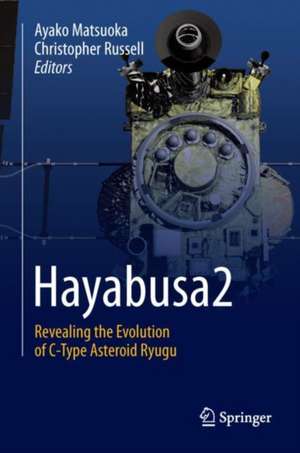Hayabusa2: Revealing the Evolution of C-Type Asteroid Ryugu
Editat de Ayako Matsuoka, Christopher T. Russellen Limba Engleză Hardback – 19 sep 2018
Originally published in Space Science Reviews, Volume 208, Issue 1-4, July 2017
| Toate formatele și edițiile | Preț | Express |
|---|---|---|
| Paperback (1) | 797.19 lei 38-44 zile | |
| SPRINGER NETHERLANDS – 26 ian 2019 | 797.19 lei 38-44 zile | |
| Hardback (1) | 962.52 lei 3-5 săpt. | |
| SPRINGER NETHERLANDS – 19 sep 2018 | 962.52 lei 3-5 săpt. |
Preț: 962.52 lei
Preț vechi: 1173.82 lei
-18% Nou
Puncte Express: 1444
Preț estimativ în valută:
184.20€ • 191.22$ • 153.59£
184.20€ • 191.22$ • 153.59£
Carte disponibilă
Livrare economică 04-18 martie
Preluare comenzi: 021 569.72.76
Specificații
ISBN-13: 9789402415377
ISBN-10: 9402415378
Pagini: 449
Ilustrații: VII, 449 p. 337 illus., 239 illus. in color.
Dimensiuni: 155 x 235 mm
Greutate: 0.94 kg
Ediția:1st ed. 2018
Editura: SPRINGER NETHERLANDS
Colecția Springer
Locul publicării:Dordrecht, Netherlands
ISBN-10: 9402415378
Pagini: 449
Ilustrații: VII, 449 p. 337 illus., 239 illus. in color.
Dimensiuni: 155 x 235 mm
Greutate: 0.94 kg
Ediția:1st ed. 2018
Editura: SPRINGER NETHERLANDS
Colecția Springer
Locul publicării:Dordrecht, Netherlands
Cuprins
Editorial to Topical Volume on: Hayabusa2: Revealing the Evolution of C-Type Asteroid Ryugu.- Hayabusa2 Mission Overview.- Preflight Calibration Test Results for Optical Navigation Camera Telescope (ONC-T) Onboard the Hayabusa2 Spacecraft.- Development of the Laser Altimeter (LIDAR) for Hayabusa2.- Albedo Observation by Hayabusa2 LIDAR: Instrument Performance and Error Evaluation.- Dust Detection Mode of the Hayabusa2 LIDAR.- Hayabusa2 Sampler: Collection of Asteroidal Surface Material.- Hayabusa2 Sample Catcher and Container: Metal-Seal System for Vacuum Encapsulation of Returned Samples with Volatiles and Organic Compounds Recovered from C-Type Asteroid Ryugu.- System Configuration and Operation Plan of Hayabusa2 DCAM3-D Camera System for Scientific Observation During SCI Impact Experiment.- Deployable Camera (DCAM3) System for Observation of Hayabusa2 Impact Experiment.- The Small Carry-on Impactor (SCI) and the Hayabusa2 Impact Experiment.- Scientific Objectives of Small Carry-on Impactor (SCI) and Deployable Camera 3 Digital (DCAM3-D): Observation of an Ejecta Curtain and a Crater Formed on the Surface of Ryugu by an Artificial High-Velocity Impact.- Performance of Hayabusa2 DCAM3-D Camera for Short-Range Imaging of SCI and Ejecta Curtain Generated from the Artificial Impact Crater Formed on Asteroid 162137 Ryugu (1999 JU3JU3 ).- Thermal Imaging Performance of TIR Onboard the Hayabusa2 Spacecraft.- Thermal Infrared Imaging Experiments of C-Type Asteroid 162173 Ryugu on Hayabusa2.- Feasibility and Accuracy of Thermophysical Estimation of Asteroid 162173 Ryugu (1999 JU3) from the Hayabusa2 Thermal Infrared Imager.- NIRS3: The Near Infrared Spectrometer on Hayabusa2.- MASCOT—The Mobile Asteroid Surface Scout Onboard the Hayabusa2 Mission.- The Camera of the MASCOT Asteroid Lander on Board Hayabusa 2.- The MicrOmega Investigation Onboard Hayabusa2.- The MASCOT RadiometerMARA for the Hayabusa 2 Mission.- The MASCOT Magnetometer.
Notă biografică
Dr. Ayako Matsuoka has been involved in scientific studies and instrument development for space missions of the Institute of Space and Astronautical Science, Japan Aerospace Exploration Agency (JAXA).
Professor Chris Russell has provided instruments for missions flown by both NASA and ESA and has studied the planetary and terrestrial measurements returned by the American, European, Russian and Canadian space programs beginning in 1964.
Textul de pe ultima copertă
In December 2014, Hayabusa2 started its journey to 162173 Ryugu, a C-type asteroid likely to be primordial, thereby making this a voyage in both space and time. Hayabusa2 will begin its observations upon arrival at Ryugu in 2018. It will survey the asteroid's surface features, touch down on the asteroid, form an artificial crater by shooting an impactor, and collect sample materials both on and under the surface. In 2020, Hayabusa2 will return to Earth and release a re-entry capsule carrying material from Ryugu.
This book contains papers describing the scientific objectives and instrumentation on Hayabusa2 and its landing package, MASCOT. The methods and developments presented in these papers have challenged the state-of-the-art of planetary exploration. This book is indispensable to understanding the results that Hayabusa2 will bring through its in situ and sample return exploration.
Originally published in Space Science Reviews,Volume 208, Issue 1-4, July 2017
Caracteristici
Serves as an encyclopedia of Hayabusa2's newly developed instruments Forms an indispensable reference to solar system evolution as determined through the study of asteroids Covers the comprehensive survey techniques used to analyze asteroidal material
